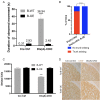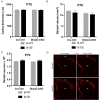TorsinB overexpression prevents abnormal twisting in DYT1 dystonia mouse models
- PMID: 32202496
- PMCID: PMC7141835
- DOI: 10.7554/eLife.54285
TorsinB overexpression prevents abnormal twisting in DYT1 dystonia mouse models
Abstract
Genetic redundancy can be exploited to identify therapeutic targets for inherited disorders. We explored this possibility in DYT1 dystonia, a neurodevelopmental movement disorder caused by a loss-of-function (LOF) mutation in the TOR1A gene encoding torsinA. Prior work demonstrates that torsinA and its paralog torsinB have conserved functions at the nuclear envelope. This work established that low neuronal levels of torsinB dictate the neuronal selective phenotype of nuclear membrane budding. Here, we examined whether torsinB expression levels impact the onset or severity of abnormal movements or neuropathological features in DYT1 mouse models. We demonstrate that torsinB levels bidirectionally regulate these phenotypes. Reducing torsinB levels causes a dose-dependent worsening whereas torsinB overexpression rescues torsinA LOF-mediated abnormal movements and neurodegeneration. These findings identify torsinB as a potent modifier of torsinA LOF phenotypes and suggest that augmentation of torsinB expression may retard or prevent symptom development in DYT1 dystonia.
Keywords: basal ganglia; cholinergic interneuron; developmental biology; dystonia; genetic redundancy; mouse; mouse model; movement disorder; neuroscience.
© 2020, Li et al.
Conflict of interest statement
JL, CL, SP, WD No competing interests declared
Figures
















References
-
- Akbari MT, Zand Z, Shahidi GA, Hamid M. Clinical features, DYT1 mutation screening and genotype-phenotype correlation in patients with dystonia from Iran. Medical Principles and Practice : International Journal of the Kuwait University, Health Science Centre. 2012;21:462–466. doi: 10.1159/000336783. - DOI - PubMed
Publication types
MeSH terms
Substances
Grants and funding
LinkOut - more resources
Full Text Sources
Other Literature Sources
Medical
Molecular Biology Databases

